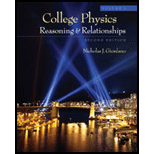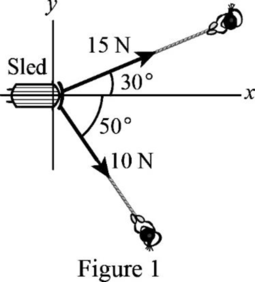
Concept explainers
(a)
The magnitude and direction of the sled’s acceleration.
(a)
Answer to Problem 43P
The magnitude of the sled’s acceleration is
Explanation of Solution

Write the expression for the Newton’s second law of motion acting on the surface.
Here,
Since the surface is frictionless, the only forces in the plane of the motion are the children’s force.
Using the figure
Here,
Using the figure
Here,
Use equation (II) to solve for
Use equation (III) to solve for
Write the expression for the magnitude of the acceleration.
Here,
Write the expression for the direction of the acceleration.
Conclusion:
Substitute
Substitute
Substitute
Substitute
Below the
Therefore, the magnitude of the sled’s acceleration is
(b)
The time taken by the sled to reach a speed of
(b)
Answer to Problem 43P
The time taken by the sled to reach a speed of
Explanation of Solution
Write the expression for the equation of motion.
Here,
The sled is initial at rest with velocity
Use equation (VIII) to solve for
Conclusion:
Substitute
Therefore, the time taken by the sled to reach a speed of
Want to see more full solutions like this?
Chapter 4 Solutions
COLLEGE PHYSICS,VOL.1
- A capacitor with a capacitance of C = 5.95×10−5 F is charged by connecting it to a 12.5 −V battery. The capacitor is then disconnected from the battery and connected across an inductor with an inductance of L = 1.55 H . At the time 2.35×10−2 s after the connection to the inductor is made, what is the current in the inductor? At that time, how much electrical energy is stored in the inductor?arrow_forwardCan someone help me with this question. Thanks.arrow_forwardCan someone help me with this question. Thanks.arrow_forward
 Principles of Physics: A Calculus-Based TextPhysicsISBN:9781133104261Author:Raymond A. Serway, John W. JewettPublisher:Cengage Learning
Principles of Physics: A Calculus-Based TextPhysicsISBN:9781133104261Author:Raymond A. Serway, John W. JewettPublisher:Cengage Learning Glencoe Physics: Principles and Problems, Student...PhysicsISBN:9780078807213Author:Paul W. ZitzewitzPublisher:Glencoe/McGraw-Hill
Glencoe Physics: Principles and Problems, Student...PhysicsISBN:9780078807213Author:Paul W. ZitzewitzPublisher:Glencoe/McGraw-Hill Physics for Scientists and Engineers: Foundations...PhysicsISBN:9781133939146Author:Katz, Debora M.Publisher:Cengage Learning
Physics for Scientists and Engineers: Foundations...PhysicsISBN:9781133939146Author:Katz, Debora M.Publisher:Cengage Learning Classical Dynamics of Particles and SystemsPhysicsISBN:9780534408961Author:Stephen T. Thornton, Jerry B. MarionPublisher:Cengage Learning
Classical Dynamics of Particles and SystemsPhysicsISBN:9780534408961Author:Stephen T. Thornton, Jerry B. MarionPublisher:Cengage Learning Physics for Scientists and Engineers, Technology ...PhysicsISBN:9781305116399Author:Raymond A. Serway, John W. JewettPublisher:Cengage Learning
Physics for Scientists and Engineers, Technology ...PhysicsISBN:9781305116399Author:Raymond A. Serway, John W. JewettPublisher:Cengage Learning Physics for Scientists and Engineers with Modern ...PhysicsISBN:9781337553292Author:Raymond A. Serway, John W. JewettPublisher:Cengage Learning
Physics for Scientists and Engineers with Modern ...PhysicsISBN:9781337553292Author:Raymond A. Serway, John W. JewettPublisher:Cengage Learning





